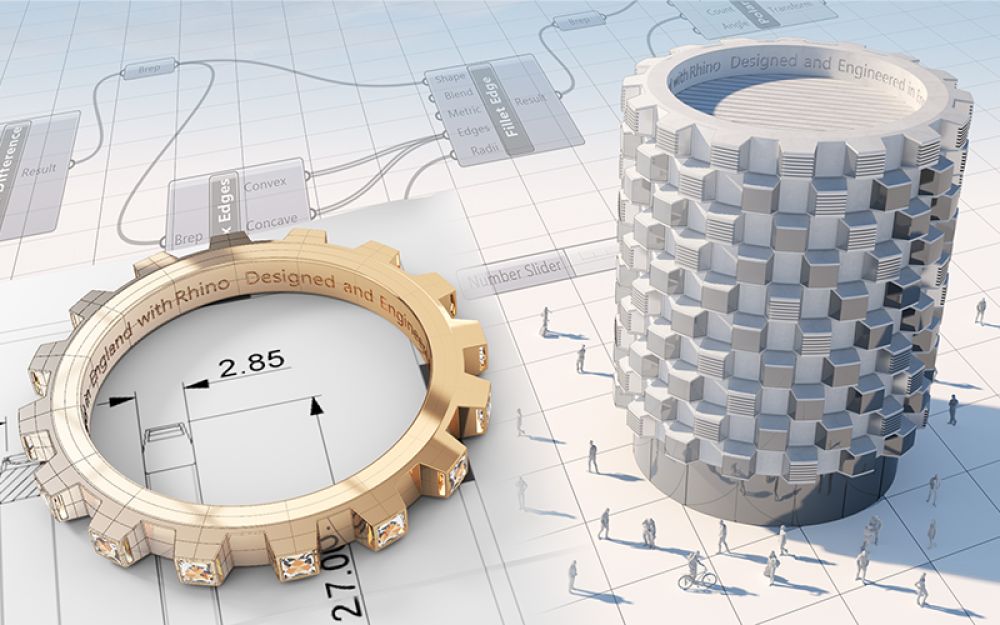Rhino 3D, or simply Rhino, is a versatile 3D modeling software that has been gaining popularity among designers, architects, engineers, and professionals from various other fields. It is known for its powerful modeling capabilities, precision, and flexibility. In this blog, we’ll dive deep into what Rhino 3D is, its features, benefits, and why it stands out in the world of computer-aided design (CAD).
What is Rhino 3D?
Rhino 3D, also known as Rhino, or Rhinoceros, is a commercial 3D computer graphics and computer-aided design (CAD) application software developed by Robert McNeel & Associates. It is widely used in various industries such as architecture, industrial, jewelry , automotive, and marine design, among others. Rhino is particularly famous for its versatility in modeling complex geometries with a mathematical precision that employs NURBS (Non-Uniform Rational B-Splines).
The software provides a broad range of tools for free-form surface modeling, as well as the ability to edit complex models with advanced features like Boolean operations, filleting, and shelling. Rhino also supports polygon meshes and point clouds, which makes it flexible for a variety of modeling tasks. Furthermore, Rhino has a wide array of plug-ins available, which extends its capabilities to include rendering, animation, and engineering analysis.
Designed with an open SDK (Software Development Kit), Rhino encourages a growing community of developers to create custom tools and workflows tailored to specific industries. The software’s ability to exchange files with other design, drafting, CAM, engineering, analysis, rendering, animation, and illustration software makes it a versatile component of the design and manufacturing ecosystem.
Key Features of Rhino 3D
Precision
Rhino is capable of designing, analyzing, and creating anything from an airplane to jewelry with extreme precision. It allows users to work on complex models without worrying about the limitations often found in other modeling software.
Compatibility
Rhino supports a wide range of file formats, making it easy to import and export designs to and from different platforms. This compatibility is crucial for collaborative work environments where various software applications are used.
Versatility
Rhino can handle projects of any size, and it’s well-suited for both 2D and 3D modeling. This flexibility enables users to switch between different design dimensions without having to rely on multiple software solutions.
Accessible Scripting and Plugins
Rhino’s open architecture allows for scripting in languages like Python and RhinoScript, as well as the development of custom plugins. This openness has led to a vast array of third-party extensions that can tailor the software to specific needs.
3D Capture and Point Clouds
Rhino also excels at 3D capture and point clouds, supporting large scanning projects and digitizing physical objects into 3D models. This is particularly useful for reverse engineering and digital archival.
Benefits of Using Rhino 3D
User-Friendly Interface
Despite its advanced capabilities, Rhino is known for having an intuitive interface that is accessible to beginners while still offering deep functionality for experienced users.
Educational Resources
There is a wealth of learning materials available for Rhino users. From tutorials and forums to books and training courses, the Rhino community is active and supportive.
High-Quality Visuals
Rhino works seamlessly with rendering plugins like V-Ray and KeyShot, allowing users to create photorealistic images and animations. This integration is essential for presentations and pitches where visual quality can make all the difference.
Cost-Effectiveness
Compared to some other high-end CAD software, Rhino is relatively affordable. This cost-effectiveness makes it an attractive option for small businesses and individual professionals.
Customization
The ability to customize Rhino through programming or plugins means that it can be adapted for specific workflows or industries. Custom tools can be developed without compromising the core functionality of the software.
Applications of Rhino 3D
Rhino’s versatility makes it applicable in a wide range of industries. Here are some areas where Rhino is particularly effective:
Architecture
Architects use Rhino for conceptual design, parametric modeling, and complex form generation. It integrates well with BIM (Building Information Modeling) tools like Revit.
Industrial Design
Product designers appreciate Rhino’s precision and flexibility when it comes to creating smooth, organic forms as well as technical prototypes.
Jewelry Design
The intricate details required in jewelry design are well-suited to Rhino’s capabilities. The software can create detailed 3D models ready for 3D printing or traditional manufacturing.
Automotive and Marine Design
Rhino’s ability to create complex curves and surfaces makes it ideal for designing the aerodynamic forms found in cars and boats.
Aerospace
The aerospace industry requires extreme precision and specialized shapes that are easily managed with Rhino’s powerful NURBS engine.
Art and Sculpture
Artists use Rhino to explore complex geometries and to bring their visions to life with digital fabrication methods such as CNC machining or 3D printing.
Learning Rhino 3D
For those interested in learning Rhino 3D, there are numerous resources available:
- Official Training: Robert McNeel & Associates offer official training courses for all levels.
- Online Tutorials: Websites like YouTube have thousands of video tutorials covering everything from the basics to advanced techniques.
- Books: There are several comprehensive books dedicated to learning Rhino.
- Community Forums: The Rhino community is an excellent place to seek advice, share knowledge, and find inspiration.
- Certification Programs: For professionals who want to prove their proficiency in Rhino, certification programs are available.
Rhino 3D Software for Jewelry Design
Rhino 3D Software, also known as Rhinoceros, is a versatile 3D modeling tool that has become a staple for jewelry designers seeking precision and complexity in their creations. Its powerful NURBS engine enables designers to create intricate and sophisticated designs that would be challenging or impossible to achieve using traditional hand-drawing or jewelry-making techniques.
With Rhino, jewelry designers can effortlessly manipulate curves, surfaces, solids, and meshes to craft detailed models of rings, bracelets, necklaces, and other bespoke jewelry items. The software’s ability to render photorealistic images ensures that designers can visualize their final products and make necessary adjustments before the piece goes into production, saving both time and resources.
Rhino’s compatibility with numerous plug-ins, such as Matrix and RhinoGold, further enhances its capabilities specifically for jewelry design. These plug-ins offer specialized tools for adding pave or channel settings, filigrees, halos, and other common jewelry details. They also provide libraries of gem cuts and settings to streamline the design process.
Another significant advantage of Rhino for jewelry design CAD software is its seamless integration with various fabrication methods. The software can generate files compatible with CNC milling machines and 3D printers. It is allowing for direct manufacturing of the designed pieces from the digital model. This capability bridges the gap between design and production. It is facilitating rapid prototyping and enabling jewelers to bring intricate designs to market with speed and efficiency.
Having a good knowledge and experience with Rhino can help you land a good job as CAD Jewellery designer. You can apply as Full Time or do Freelancing for CAD. Many job portals and freelancing portals such as Upwork provide these services.
The Future of Rhino 3D
The future of Rhino 3D software is poised for significant evolution, integrating cutting-edge technologies to enhance its capabilities in various industries. As a cornerstone in the fields of architecture, industrial design, and multimedia, Rhino 3D will likely expand its toolset to include more advanced features like machine learning algorithms that can predict user design patterns and automate repetitive tasks, thereby increasing efficiency and offering personalized experiences.
Parametric modeling will see further advancements with Rhino, allowing designers to explore more complex geometries and responsive designs. This could be coupled with real-time rendering improvements, providing instant visual feedback on material properties and environmental factors, bridging the gap between digital and physical realities.
Collaboration tools are expected to evolve, with cloud-based platforms enabling seamless teamwork across global projects. Rhino could integrate version control systems and multi-user environments, allowing multiple designers to work on the same model simultaneously without conflicts, enhancing productivity and creativity.
Sustainability will also be a key focus for the future of Rhino. The tools in developing process is focusing on analyzing environmental impact and material efficiency during the design process. This will empower designers to make informed decisions about their projects’ ecological footprints.
In conjunction with virtual and augmented reality technologies, Rhino 3D’s future will likely offer immersive design experiences, where users can walk through their creations in a virtual space, making design reviews and client presentations more interactive and impactful.
Rhino is giving continuous software updates and an active community of developers creating custom plugins and tools. The Rhino 3D is set to remain at the forefront of digital design innovation, shaping the way we create and interact with the three-dimensional world around us.
Conclusion
Rhino 3D is a robust software that caters to a variety of design and modeling needs. It stands out due to its precision, versatility, and community support.Are you an architect, engineer, product designer, or artist?. Rhino offers the tools and flexibility to translate your ideas into reality.
In the world of digital design, having the right software can make a significant difference. Rhino 3D’s commitment to quality and user satisfaction makes it a compelling choice for anyone looking to push the boundaries of 3D modeling.





